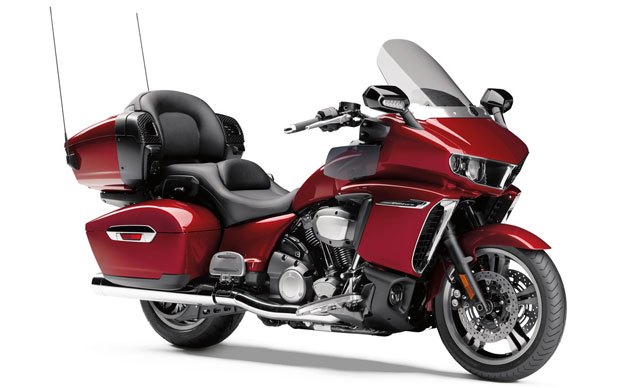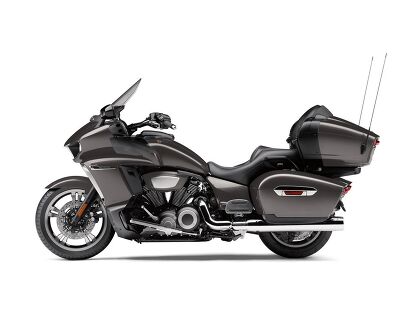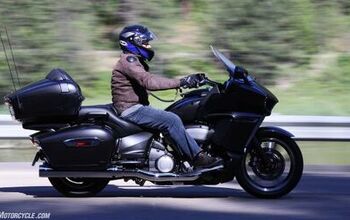2018 Yamaha Star Venture Revealed
Yamaha's new Transcontinental Touring Star
Yamaha has the FJR1300 and FJ-09 to cover the sport-touring segment, and its Super Ténéré can add some adventure to a rider’s tour. Then there’s the V Star 1300s for cruisers with some touring amenities. But what’s missing is a luxurious tourer that can muscle in on Harley’s extensive touring lineup or even on Honda’s venerable Gold Wing.
Yamaha’s marketers note that touring customers are often forced into a traditional/emotional choice like a Harley or a modern/luxury mount like a Gold Wing or BMW. “We thought,” said Derek Brooks, Yamaha’s Motorcycle Product Line Manager, “Why not offer both?”
With the imminent introduction of the new Star Venture to the North American market, Yamaha takes a bold step into the luxury-touring category, what it terms as “Transcontinental Touring.” Helping make miles melt under its wheels are a touchscreen infotainment cluster, ride-by-wire cruise and traction controls, scads of stowage space, an electrically adjustable windscreen, heated grips and seats, and an electric motor to help maneuver the bike in parking situations, both forward and reverse.
When you notice the Venture is powered by an 1854cc V-Twin, you might think of the defunct Roadliner/Stratoliner’s air-cooled lump still employed in the Raider. You’d be right and wrong. The bore and stroke remain the same, but the Venture’s 113 c.i. mill is nearly a complete redo. It uses new cases to stuff in a six-speed gearbox and employs a new side-draft intake that creates extra space for fuel, a fairly generous 6.6 gallons.
The overhead-valve motor now uses twin counterbalancers and composite rubber engine mounts (unlike the Road/Stratoliners) to keep vibes from becoming bothersome during long days in the heated saddle. Yamaha notes the engine’s lack of overhead cams and the dry-sump lubrication help lower the mill’s center of mass. Both fifth and sixth gears are overdriven, which results in the 4-valve motor spinning at just 2750 rpm when cruising at 75 mph. Purported peak torque of 126 lb-ft occurs at just 2500 rpm. Hydraulic valves and a belt final drive minimize maintenance concerns. The last time we dyno tested a Star ’Liner was in 2013, and the motor in that state of tune produced a healthy 82 hp and a staggering 103.5 lb-ft of torque at its rear wheel. Due to the Venture’s new intake, that horsepower number is likely to suffer the loss of a few ponies.
Attached to each side of the engine is a 375-watt alternator, yielding 750 total watts to power all the doo-dads and gee-gaws touring riders desire. Electric power is also required for the 3.5 inches of windshield adjustment, heated grips and seats, and the “Sure-Park parking assist,” which uses an electric motor to help move the Venture forward and reverse in challenging parking scenarios.
The Star Venture’s styling is likely to polarize opinions. Its sharp lines originated in the USA, along with Yamaha’s design contractor GKDI in SoCal. Yamaha reps note the bike’s lunging forward motion and tensioned surfaces draw some inspiration from a Plymouth ’Cuda muscle car and a P-51 Mustang fighter plane. Lighting is all LED, including the four headlights, the tail-light and the mirror-mounted front turn signals.
“This thing punches a hole in the darkness like no other motorcycle I’ve ever ridden,” commented Dan Ruesch, Motorcycle Product Planning. “It’s unbelievable.”
Luxury comes in the forms of comfort, convenience, adjustability, and amenities.
A smart key fob controls electric luggage locks and fuel door, as well as allowing a rider to start the Venture without using the key. It also has a finder feature and arms the security alarm.
Seats are generously sized and are equipped standard with heating elements front and rear. Additionally, the rider backrest is adjustable to three positions and heated, while the the passenger backrest has a heating element and is 17 inches wide for comfortable support.
Both hand levers are adjustable for reach, and the rider’s floorboards are bountifully long; passenger floorboards can be set to one of two height positions. More adjustability is found in the mid-fairing wind deflectors and lower fairing wind vents.
Yamaha claims its new touring bike has more than 37 gallons of storage space and that its cavernous trunk can hold two extra-large full-face helmets. Locking saddlebags are augmented by two handy compartments in the fairing and one in the lower-left side fairing panel. Passengers have access to two other compartments on the forward ends of the trunk. Two USB ports are standard, one in a fairing pocket along with a 12-volt port, and one in the trunk.
The USB ports can also integrate with the Venture’s 7-inch LCD touchscreen infotainment system made by Harman, the company’s first such system for a Japanese OEM. Inputs can be controlled via touchscreen, handlebar switches or voice commands via an accessory headset. The audio package has AM/FM radio and can also play pre-recorded music or stream Pandora from a smartphone via the USB or Bluetooth wireless connection options, delivered through a pair of speakers in the fairing or a headset’s speakers.
The Star Venture uses a completely new frame, with steel tubing for the main chassis with an aluminum subframe. The subframe doubles as an oil reservoir and is said to help shed heat. As with every cruiser, the Venture features a low seat height: 27.4 inches.
Despite that modest distance from the ground, Yamaha was able to equip its transcontinental tourer with a robust amount of suspension travel. The 46mm fork has 5.1 inches of stroke, while the single shock has 4.3-inches of rear travel with remote hydraulic preload adjustability. No damping adjustments are available. And despite the Venture’s prodigious weight, Yamaha claims it requires 22% less effort to lift off its sidestand than its Motor Company competition.
Vehicular luxury never comes cheap, and so it is with the Star Venture. Credit Yamaha’s product planners for not trying to sell a decontented cut-rate version, instead starting fully equipped at $24,999 in Granite Gray or Raspberry Metallic. The only choice is to decide to tick the box for the Transcontinental option. A 5-year warranty is standard.
A $500 deposit gets earliest deliveries via Yamaha’s Priority Delivery Program, and the Venture will begin arriving at dealers in August. If you’re interested but will need to ride the Venture before committing to it, demo opportunities will be available at several events this summer, including Star Days, Sturgis, AIMExpo, and Biketoberfest. A full list of events can be found here.
2018 Yamaha Star Venture Specifications | |
|---|---|
| MSRP | $24,999; $26,999 with Transcontinental option |
| Engine | Type 113-cubic-inch (1854cc) air-cooled OHV V-twin; 8 valves |
| Bore x Stroke | 100.0mm x 118.0mm |
| Compression Ratio | 9.5:1 |
| Fuel Delivery | Fuel Injection with YCC-T and D-Mode |
| Transmission | 6-speed; multiplate assist and slipper wet clutch |
| Final Drive | Belt |
| Front Suspension | 46mm telescopic fork; 5.1-in travel |
| Rear Suspension | Single shock with remote preload adjustment; 4.3-in travel |
| Front Brakes | Dual hydraulic disc, 298mm discs; Unified Brake System and ABS |
| Rear Brake | Hydraulic disc, 320mm; Unified Brake System and ABS |
| Front tire | 130/70-R18 Bridgestone Exedra |
| Rear tire | 200/55-R16 Bridgestone Exedra |
| L x W x H | 106.3 in x 39.9 in x 55.5 – 59.1 in |
| Seat Height | 27.4 in |
| Wheelbase | 67.6 in |
| Rake | 31.0° |
| Trail | 5.7 in |
| Ground Clearance | 5.5 in. |
| Fuel Capacity | 6.6 gal |
| Fuel Economy | 34 mpg |
| Wet Weight | 957 lbs (963 lbs for TransContinental package) |
| Warranty | 5 Year (One year limited factory warranty + Four years Yamaha Extended Service) |
| Colors | Granite Gray; Raspberry Metallic |
More by Kevin Duke












































































Comments
Join the conversation
An air-cooled V-Twin! Why didn't I think of that? (face palm).
I guess my thoughts and excitement about the Yamaha can be summed up this way. I love all motorcycles. Yamaha was my very first experience in two wheeled freedom. My parents bought me a Yamaha Riva (50cc) scooter during my High School years and later after graduating, I bought my first full fledged "big bike" which was a 1982 Yamaha Seca 650. Loved that bike. Still do. Wish I had it today. That said, I've owned all kinds of bikes over the past 3 decades of riding and anybody who's read any of my posts would know that I have a special love for Harley's. At this stage in my life, I'm mostly a touring rider, although I pretty much always have been, it's just that I didn't know it at the time and many of the bikes I owned weren't of the touring variety. About the time I hit my 30's. That was the moment, when I began craving a Harley. First I wanted the Heritage Softail, then my lust turned to the Road King, then the Road Glide...and in the end, I decided to skip past all those and just go with the king of the hill and buy an Ultra. 5 years later, I bought another Ultra to replace the first. So now having established my deep love for Harley's, you might find it odd when I tell you that I've been anxious to ride something other than a Harley. Huh? Yes....true. As much as I love them, Harley's are pretty much in a class unto their own. So when Indian came back on the scene I became very excited about the prospect of maybe switching brands. The Roadmaster held a lot of promise and I do like the way the bike handles and I especially love the silky smooth transmission and the easy clutch lever. That said, I don't care for the styling of the bike that much and I really dislike the infotainment setup. To me eyes, it's like having an enormous I-Pad strapped to the dashboard. To huge and unsightly for my eyes. It's functional and I'm sure many riders who have joined the over 40 club with slight vision problems might find it more useful. It's just not my taste. So I ruled out the Indian and again set my sights on another Harley, only this time I thought I'd buy a Road Glide (Ultra). I like Honda's very much, but to be honest I'm just not a Goldwing guy no matter how hard I try to like them. Great bikes...just not for me. I already own a BMW (my second) and clearly it hasn't been able to hold my interest, so what's left? Well....in terms of big luxo-touring bikes, the answer is, Nothing! That is until, now.
Many of the younger riders in this crowd probably are too young to remember the big touring barges of the 80's, but I do. The Honda Goldwing,the Suzuki Calvacade, the Kawasaki Voyager and the Yamaha Venture. It was an all out war between the big 4 Japanese brands to see who would become king of the hill. In the end, Honda won the war and the Goldwing has remained as the undefeated champion since. Suzuki no longer offers a big touring barge, Yamaha and Kawasaki both has been on/off with production of the Venture and Voyager line, but without much notoriety or success. This new bike from Yamaha truly has the potential to turn the (V-twin) touring segment upside down. There are plenty of other riders like myself who want to see a healthy and robust competition in the touring segment again, like it was back in the day. Think of it this way...the 600cc sport bike class is probably by far the most competitive segment across all the major brands. The Ninja, the CBR, the R6, the GSX-R....these bikes are legendary. They also cost half as much as the bike were's discussing. So it stands to reason that at this price point, the competition should be fierce. Statistics show that the touring category is the most popular among all the bikes HD sells and that segment has continued to grow overall. I think Yamaha did their market research, saw the opportunity and went for it. The current Goldwing is aging rapidly, the Kawasaki Voyager is getting a little dated also, now approaching 10 years in it's current form. I think the timing was about as perfect as it could get for Yamaha to bring out this new model. I look forward to reading the reviews and long term ride reports comparing this bike to the rest of the touring segment.